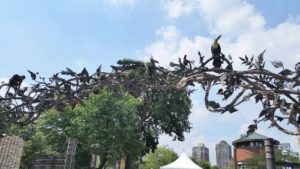When we left Chicago, I was wondering if I got any decent pictures of Lincoln Park. As it turned out, the only pictures of the park that weren’t of the zoo that I got, as it turned out, were one picture of the Couch mausoleum that I took from a moving bus (so it’s not the best picture ever), a few pictures of the Albert Caldwell Lily Pool, and a couple of pictures of the beach just a little south of where Lake Shore Drive would intersect with Belden Avenue if Belden Avenue went through. Which it doesn’t.
Anyway, I haven’t found anything that I liked well enough to showcase in my post on Lincoln Park, so on to the zoo. I have 47 pictures from the zoo, so I’m sure that I can find something that I can work with there.
Lincoln Park Zoo began, for all intents and purposes, with two swans in 1868. In 1874, a bear cub joined the swans, and the zoo was underway. I’m not sure when exactly the “there are two swans and a bear cub in Lincoln Park” gave way to a formal “Lincoln Park Zoo,” but the first zoo director, Cyrus DeVry, was hired in 1888, so it’s likely to have been somewhere in that period.
Over time, the zoo grew, with the addition of new buildings and species. Today, there are over 1,000 specimens of over 200 species in the zoo.

At the moment (and for the foreseeable future), Lincoln Park Zoo is free to the public. I don’t normally talk about admissions fees because that’s not “evergreen.” Someday the admissions cost will go up which means that one of two things would have to happen. One, I would have to track the cost of admission to absolutely everything that I’ll ever write about that has an admission fee (the Art Institute of Chicago, the San Antonio Zoo, the Empire State Building, the Ruins of Pompeii) and then keep those pages updated. Two, I would have to resign myself to having out-of-date information on my page. And, honestly, this is what would be more likely to happen.
I’m making an exception to the above rule in this case because not having an admission charge is highly unusual. There are 142 accredited zoos in the United States and of those, from what I can tell, fewer than ten have no admission fee. In the case of Lincoln Park Zoo, the money to run the zoo is largely covered by the fee for parking in the lots near the zoo and the sale of food and souvenirs. They take donations as well, and I threw a few dollars in that bucket while I was there. Any shortfall beyond that is covered by the city. The parking lot, by the way, is not a “throw a quarter in the meter” type parking. It costs roughly the same as any private parking lot in a big city. Therefore it’s more cost-effective to drive if you have several people in the car with you. On this visit, we didn’t drive; we didn’t have a car available to us. We took the bus.
As one would imagine from the location, Lincoln Park Zoo is a lovely, parklike zoo, with lots of greenery. It’s a nice place to do some walking and watch the people and the animals. There is food available at the zoo, the most prominent of which (at least it’s the only one that stood out to me) is the food court at the Park Place Café. This food court has been there since Alex was maybe three, so it’s likely to turn out to be a long-term fixture at the zoo.
As to the animals, well, there are animals at the zoo. I think that the western lowland gorillas made the biggest impression on me. This is at least in part to the fact that a silverback was leaning up against the join between two windows when we were there, allowing me to get several really lovely pictures of him. Of course, gorillas and Lincoln Park Zoo have had a long association. In 1930, the zoo acquired a gorilla named Bushman. Bushman lived for another 21 years at the zoo, and during my childhood, most of the adults in my life had fond memories of him. He was taxidermied and is on display at the Field Museum of Natural History.
